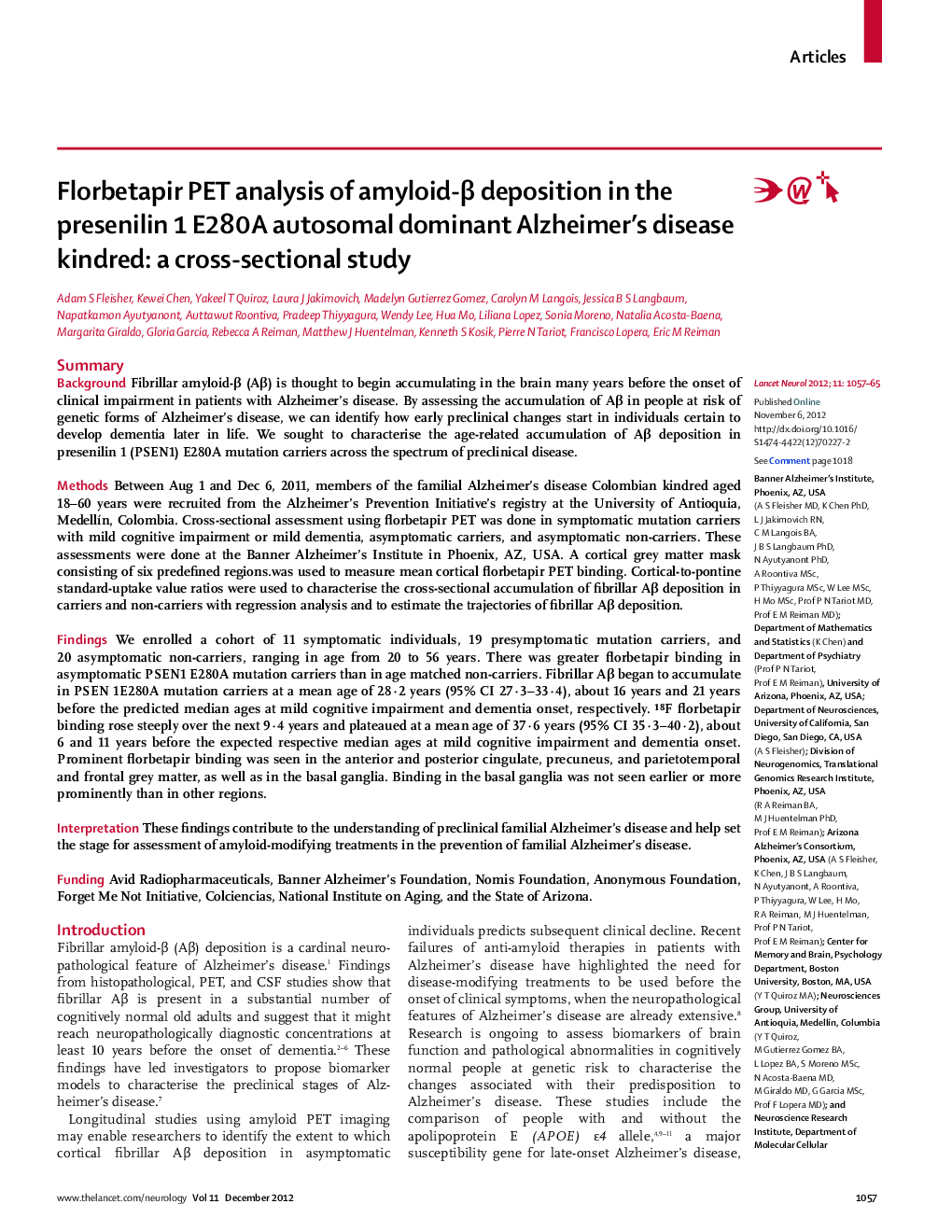| Article ID | Journal | Published Year | Pages | File Type |
|---|---|---|---|---|
| 3066510 | The Lancet Neurology | 2012 | 9 Pages |
SummaryBackgroundFibrillar amyloid-β (Aβ) is thought to begin accumulating in the brain many years before the onset of clinical impairment in patients with Alzheimer's disease. By assessing the accumulation of Aβ in people at risk of genetic forms of Alzheimer's disease, we can identify how early preclinical changes start in individuals certain to develop dementia later in life. We sought to characterise the age-related accumulation of Aβ deposition in presenilin 1 (PSEN1) E280A mutation carriers across the spectrum of preclinical disease.MethodsBetween Aug 1 and Dec 6, 2011, members of the familial Alzheimer's disease Colombian kindred aged 18–60 years were recruited from the Alzheimer's Prevention Initiative's registry at the University of Antioquia, Medellín, Colombia. Cross-sectional assessment using florbetapir PET was done in symptomatic mutation carriers with mild cognitive impairment or mild dementia, asymptomatic carriers, and asymptomatic non-carriers. These assessments were done at the Banner Alzheimer's Institute in Phoenix, AZ, USA. A cortical grey matter mask consisting of six predefined regions.was used to measure mean cortical florbetapir PET binding. Cortical-to-pontine standard-uptake value ratios were used to characterise the cross-sectional accumulation of fibrillar Aβ deposition in carriers and non-carriers with regression analysis and to estimate the trajectories of fibrillar Aβ deposition.FindingsWe enrolled a cohort of 11 symptomatic individuals, 19 presymptomatic mutation carriers, and 20 asymptomatic non-carriers, ranging in age from 20 to 56 years. There was greater florbetapir binding in asymptomatic PSEN1 E280A mutation carriers than in age matched non-carriers. Fibrillar Aβ began to accumulate in PSEN 1E280A mutation carriers at a mean age of 28·2 years (95% CI 27·3–33·4), about 16 years and 21 years before the predicted median ages at mild cognitive impairment and dementia onset, respectively. 18F florbetapir binding rose steeply over the next 9·4 years and plateaued at a mean age of 37·6 years (95% CI 35·3–40·2), about 6 and 11 years before the expected respective median ages at mild cognitive impairment and dementia onset. Prominent florbetapir binding was seen in the anterior and posterior cingulate, precuneus, and parietotemporal and frontal grey matter, as well as in the basal ganglia. Binding in the basal ganglia was not seen earlier or more prominently than in other regions.InterpretationThese findings contribute to the understanding of preclinical familial Alzheimer's disease and help set the stage for assessment of amyloid-modifying treatments in the prevention of familial Alzheimer's disease.FundingAvid Radiopharmaceuticals, Banner Alzheimer's Foundation, Nomis Foundation, Anonymous Foundation, Forget Me Not Initiative, Colciencias, National Institute on Aging, and the State of Arizona.
